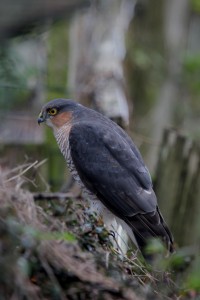 It was a typical garden feeding station at this time of the year with a number feeders with a range of food. Greenfinches were at the peanuts and sunflower hearts and there were no less than ten blackbirds attacking the cut up apples as only they can. Three yellowhammers were feeding on the ground on mixed seed and blue, great and coal tits were at all the feeders as if they were not worried which food they took. Then suddenly most of the birds scattered, although a few chaffinches remained as if they did not know what was happening. Needless to say it was a sparrowhawk but this one was different for some reason. It was the smaller male which is not surprising as I cannot ever recall seeing the larger female in the garden. Now normally these birds fly at high speed through the garden waiting for the chance to pluck a small bird out of the air. The male will take any small birds below the size of the blackbird but the larger female will take birds that include blackbirds even up to a wood pigeon.
It was a typical garden feeding station at this time of the year with a number feeders with a range of food. Greenfinches were at the peanuts and sunflower hearts and there were no less than ten blackbirds attacking the cut up apples as only they can. Three yellowhammers were feeding on the ground on mixed seed and blue, great and coal tits were at all the feeders as if they were not worried which food they took. Then suddenly most of the birds scattered, although a few chaffinches remained as if they did not know what was happening. Needless to say it was a sparrowhawk but this one was different for some reason. It was the smaller male which is not surprising as I cannot ever recall seeing the larger female in the garden. Now normally these birds fly at high speed through the garden waiting for the chance to pluck a small bird out of the air. The male will take any small birds below the size of the blackbird but the larger female will take birds that include blackbirds even up to a wood pigeon.
The sparrowhawk often misses more than it catches and normally will just carry on, at speed, through the garden to hunt elsewhere. Just occasionally, the bird will sit on a branch and look around as though contemplating where it went wrong! This particular male chose a different way as it suddenly dived into a prickly bush and began hunting for the several house sparrows that went in there. Needless to say the sparrows soon left, leaving the sparrowhawk still struggling to get through the branches at birds that had long since gone. Fortunately all this saga was happening only few feet away from my study window and I happened to have my camera to hand. When the photograph was taken the sparrowhawk was only few feet away, but taken through a glass window.
Sparrowhawks have a long square ended tail and broad, rounded wings. The male has a slate grey back and reddish, barred underparts that can appear orange at a distance. The grey tail is crossed with five or six dark bars. The female is 25% larger that the male with brown upperparts and pale brown underparts. It has a white stripe over the eye that makes it look even fiercer than the male. So what happens to these birds during the winter? The resident birds, in other words the pairs that bred in Scotland and thought to be between 8,000 to 12,000 pairs, just stay where they are. However, this situation is complicated by the fact that some, especially from Norway and Denmark, cross the North Sea and winter in the Northern Isles and along the east which includes this area. So the male sparrowhawk hunting through your garden may be a resident bird having moved from a nearby area where it bred or it could be a Scandinavian bird that will spend the winter here.
The sparrowhawks have always been much persecuted and originally by gamekeepers along with many other birds of prey. Then a further blow came from agricultural pesticides. Following the ban on such pesticides in the 1980s the number of sparrowhawks increased and the widespread planting up of plantations also helped its cause. What limits its numbers now is the decline in small bird numbers mainly from change in agricultural ways. This is why the current numbers of sparrowhawks are particularly attracted to gardens and that includes those even in the middle of Inverness. You may not see them often as they can be very secretive even with their dashing flight through gardens after their prey.
Tags: highland wildlife
